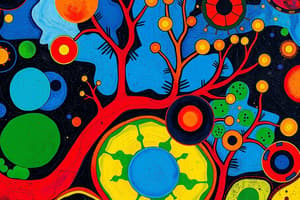Podcast
Questions and Answers
Which of the following is NOT considered a characteristic of life?
Which of the following is NOT considered a characteristic of life?
- Homeostasis
- Photosynthesis (correct)
- Metabolism
- Response to stimuli
Mitosis results in four genetically unique daughter cells.
Mitosis results in four genetically unique daughter cells.
False (B)
What is the primary purpose of meiosis?
What is the primary purpose of meiosis?
To produce genetically unique gametes for sexual reproduction.
During mitosis, the __________ phase is when sister chromatids separate.
During mitosis, the __________ phase is when sister chromatids separate.
Match the following terms with their definitions:
Match the following terms with their definitions:
Which stage of meiosis involves the exchange of genetic material between homologous chromosomes?
Which stage of meiosis involves the exchange of genetic material between homologous chromosomes?
Cellular organization is a characteristic that only applies to multicellular organisms.
Cellular organization is a characteristic that only applies to multicellular organisms.
The process by which a single parent cell divides into two daughter cells is called __________.
The process by which a single parent cell divides into two daughter cells is called __________.
Flashcards
What are cells?
What are cells?
All living things are made up of these basic units of life.
What is metabolism?
What is metabolism?
This process involves using energy to perform all life functions, like growth, repair, and reproduction.
What is growth and development?
What is growth and development?
Living things increase in size and complexity over time.
What is adaptation?
What is adaptation?
Signup and view all the flashcards
What is reproduction?
What is reproduction?
Signup and view all the flashcards
What is homeostasis?
What is homeostasis?
Signup and view all the flashcards
How do living things respond to stimuli?
How do living things respond to stimuli?
Signup and view all the flashcards
What is heredity?
What is heredity?
Signup and view all the flashcards
Study Notes
Characteristics of Life
- All living things share several key characteristics:
- Cellular organization: All living organisms are composed of cells, the basic units of life.
- Metabolism: Living things use energy to carry out their functions, including growth, repair, and reproduction.
- Growth and development: Living things increase in size and complexity during their life cycle.
- Adaptation: Living things can adapt to their environment over time through genetic changes.
- Reproduction: Living things reproduce to create offspring similar to themselves.
- Homeostasis: Living things maintain a stable internal environment, despite changes in the external environment.
- Response to stimuli: Living things react to changes in their surroundings.
- Heredity: Living organisms pass on their genetic material (DNA) to their offspring.
Mitosis
- Mitosis is a type of cell division that produces two identical daughter cells from a single parent cell.
- Used for growth, repair, and asexual reproduction in eukaryotic cells.
- The process involves several stages:
- Interphase: DNA replicates, cell grows, and prepares for division.
- Prophase: Chromosomes condense, nuclear envelope breaks down, and spindle fibers form.
- Metaphase: Chromosomes align at the metaphase plate.
- Anaphase: Sister chromatids separate and move to opposite poles.
- Telophase: Chromosomes decondense, nuclear envelope reforms, and the cell begins to divide.
- Cytokinesis: The division of the cytoplasm, separating the two daughter cells.
- Results in two genetically identical diploid cells.
Meiosis
- Meiosis is a type of cell division that produces four genetically unique daughter cells from a single parent cell.
- Used for sexual reproduction.
- Meiosis involves two rounds of division: meiosis I and meiosis II.
- Meiosis I:
- Homologous chromosomes pair up and exchange genetic material (crossing over).
- Homologous chromosomes separate, reducing the chromosome number by half.
- Results in two haploid cells.
- Meiosis II:
- Sister chromatids separate, similar to mitosis.
- Results in four haploid daughter cells, each with a unique combination of genetic material.
- Essential for generating genetic diversity within a species.
Cell Division
- Cell division is the process by which a parent cell divides into two or more daughter cells.
- Crucial for growth, repair, and reproduction in all living organisms.
- Two primary types of cell division are mitosis and meiosis.
- Mitosis produces identical copies for growth and repair.
- Meiosis produces genetically diverse cells for sexual reproduction.
- Somatic cells typically undergo mitosis; germ cells undergo meiosis.
- Proper cell division is vital for maintaining the correct chromosome number and preventing genetic disorders.
Studying That Suits You
Use AI to generate personalized quizzes and flashcards to suit your learning preferences.
Description
Explore the fundamental characteristics of life that define living organisms, such as cellular organization, metabolism, and homeostasis. Additionally, delve into the process of mitosis, a crucial method of cell division that results in two identical daughter cells. Test your understanding of these essential biological concepts.




